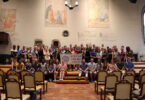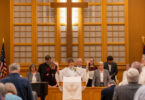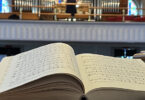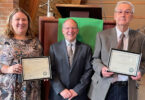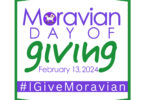We use journey language a lot in the church. Jesus’ disciples join him on the “Way.” We talk about being on a “journey of faith.” More practically, we know that if we want to get to a place where we aren’t already, we need to start where we are and intentionally travel along the road to our destination. It helps, for instance, to know that if you are going to Laurel Ridge from Winston-Salem, you’ll need to travel up the mountain on NC Highway 18 to get there.
The same can be said for worship. When we come to worship, we have different emotional starting places. Sad. Bored. Fearful. Excited. Hungry. We hope that wherever we are at the beginning of worship, something along the way will bring us to a place of comfort in God’s love and we will find strength to “Go forth to love and serve the Lord.” We hope the emotional journey of worship—wherever it begins and wherever it takes us—will be honest and meaningful.
How does such a journey in worship happen? Start by taking inventory of the emotional landscape of the people with whom you will be worshiping. Are they tired, discouraged, puzzled, hopeful? Think about the emotional destination to which you would like to take them. Find a passage of scripture that honors where your people are and where you would like to go. Plan the itinerary of the worship experience in a way that helps them make that journey with one another and with God. Leave the rest up to the Holy Spirit.
Let me give an example of a worship service based on Psalm 22, a passage chosen to help participants at the recent 2017 Youth Convo travel from one emotional place to another. During the first part of the Convo, our youth and chaperones visited three different museums in Washington, D.C. We toured the Holocaust Museum, the National Museum of the American Indian, and the Newseum.
Each of these museums invited us to experience the way human beings have disenfranchised, dislocated and exterminated each other. These museums also showed us examples of people being strong and brave, of people standing up for themselves and advocating for one another. For those in our group with open hearts, the experience of going to all three museums left us with some heavy emotions. We wondered how we would emotionally shift and be ready for the rest of our Convo experience.
Our worship at this turning point in our time together began with the laments in Psalm 22:1-18. We divided them into three sections and used each section to remember and give voice to the laments we had heard and experienced at each of the three museums. Then, we read Psalm 22:19-21a, a prayer for deliverance. We asked God to deliver us and others when we face times of trial. Next, we moved to words of hope and praise in verses 21b-31. We remembered with thanks the courage of those who had provided God’s deliverance by hiding Jews from the Nazis and by advocating for the rights of Native Americans and African Americans. Finally, we wondered how God is calling us to be courageous people.
Thinking about our starting place and then structuring our worship around Psalm 22 helped us make the emotional journey from a heavy place of despair to a purposeful place of hope for the remainder of our Convo experience and beyond.
Sometimes, as in the previous example, we begin planning worship by inventorying our own emotional starting place, finding scripture that speaks to it, then planning worship around that scripture passage. At other times, we might start with a biblical story that has lots of plot and human drama and see where it will take us. Joseph and his brothers, the Exodus story, the healing of Namaan the Syrian, Jesus’ parables, and stories about Jesus and the Early Church are all good examples. We decide to travel with the characters in a story as they make their own emotional journeys from slavery to freedom, from sickness to healing, from despair to hope. As we travel with them through their ups and down, we can become more aware of the emotional journeys we make with ourselves, each other, and God.
 When working with such a full and rich story, it’s useful to start with a blank page and build an entire order of worship up from scratch. As much as we all appreciate the comfort of a predictable order of worship that we can contentedly sink into each week, we can gain a lot by letting go of the “usual” for a time and by letting the framework of the story with its different plot turns suggest our order of worship.
When working with such a full and rich story, it’s useful to start with a blank page and build an entire order of worship up from scratch. As much as we all appreciate the comfort of a predictable order of worship that we can contentedly sink into each week, we can gain a lot by letting go of the “usual” for a time and by letting the framework of the story with its different plot turns suggest our order of worship.
Break the story up into several shorter readings and stop after each reading to pay attention to what is emotionally important at that point in the story. Do what the plot turn in the story suggests.
For instance, when a character needs help, offer a prayer of petition. When someone in the story gives a gift or gathers up resources, take up the offering. When a character helps someone else in the story, reflect on ways we can help others or do something concrete together. Make the most of images in the story – anything you can see, hear, smell, taste, or touch. Instead of a sermon, try brief reflections along the way – anything from a sentence or two to make a point or transition to a paragraph to highlight the main idea you want people to take away from the service. Involve children as much as you can. Utilize brief liturgies, dialogues, skits, songs, slide shows, videos, movement, silence and more to illustrate the emotional drama in the story.
As an example, here’s how a service based on the story of Noah and the ark might look. For each scripture passage and turn in the story’s plot, you’ll see suggestions for possible ways you could respond. This service can easily include all the standard elements we would expect in a “regular” worship service: praise, confession, petition, proclamation, offering, and benediction.
- Begin with a hymn or brief liturgy praising God for creating a beautiful world.
- Genesis 6:11-13 – God is grieved that humanity has corrupted this beautiful world with violence. Offer a prayer of confession.
- Genesis 6:14-16 – God asks Noah to build an ark. Reflect on the question, “What impossible things has God asked us to do?” Invite your children to build an ark with painted boxes. They could sing “Rise and Shine” or “One More River.”
- Genesis 6:19-22 – God instructs Noah to bring two of each kind of creature onto the ark and to gather up enough food to feed them all. Now is a good time to take up the offering for all the people we too need to care for and feed. Adults and children could have fun with animal hats and masks. You could also reflect on the question, “Whom are we willing to welcome into the boat?”
- Genesis 7:11, 17-23 – The Flood. Try a dramatic reading with sound effects (see pg 22). At the end of the reading, leave plenty of time for sad, reflective silence. Then, offer a pastoral prayer for those in our world who do not survive the trials they face and for those, like Noah, who hope against hope for the end of the storm.
- Genesis 8:13-19 – Noah’s family and the animals come off the boat. Now would be a good time to reflect on what we do with the opportunities God gives us to start all over again.
- Genesis 9:8-17 – After the Flood, God promises never to flood the earth again and gives the sign of the rainbow. Offer a brief reflection: God repents the use of destructive violence and vows not to use flood waters again.
- Close with hymns of thanks for God’s deliverance and promise. Celebrate with rainbow colored streamers or scarves. “De colores” would be a great song to sing!
- God created us with feelings, with the ability to appreciate plot and drama, and the need to make sense out of our daily and lifelong emotional journeys. We know what it is like to deal with conflict and to desire reconciliation, forgiveness and hope.
Worship is rich and rewarding when we let our own emotional journeys and those in scripture, and our larger history as Christians, speak to one another. The possibilities are endless and the rewards are great.
The Rev. Dr. Lynnette Delbridge is pastor at Central Moravian Church in Bethlehem, Pa. See her dramatic reading below.
 The Long, Long Rain Storm
The Long, Long Rain Storm
A dramatic reading of the Flood, based on Genesis 7:11-12, 17-23
For use in creative worship. By Lynnette Delbridge
In the six hundredth year of Noah’s life,
In the second month, on the seventeenth day of the month,
On that day all the fountains of the great deep burst forth.
Slowly start one or two long rain sticks. Continue
turning them faster and faster throughout the reading.
And the windows of the heavens were opened.
The rain fell on the earth forty days and forty nights.
Add a small shaker and then start shaking a gallon container of water.
The flood continued forty days on the earth;
Add “hail” sounds (shake a drum or container with stones or a rattle inside). Then add goat toes and cocoa nut shells very quietly. OPTIONAL: Add snapping fingers and tapping feet.
And the waters increased, and bore up the ark,
And the ark rose high above the earth.
The waters swelled and increased greatly on the earth;
Goat toes and cocoa nut shells get louder and louder and continue.
Cymbal crash on the word “swelled”
And the ark floated on the face of the waters.
The water swelled so mightily on the earth…
Cymbal crash on the word “swelled’
…that all the high mountains under the whole heaven were covered;
The water swelled above the mountains, covering them fifteen cubits deep.
Cymbal crash on the word “swelled”
After reader finishes “fifteen cubits deep” everyone plays louder until a fourth and final cymbal crash. Everyone stops abruptly after fourth cymbal crash.
LEAVE PERIOD OF SILENCE BEFORE READER CONTINUES
And all flesh died that moved on the earth, birds, domestic animals, wild animals, all swarming creatures that swam on the earth, and all human beings; everything on dry land in whose nostrils was the breath of life died.


